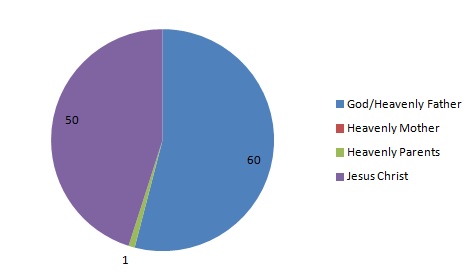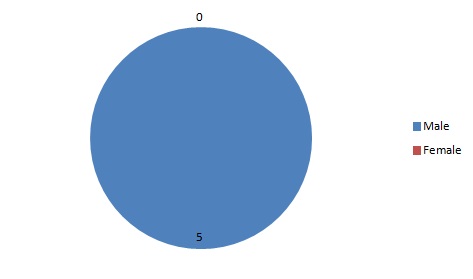Today’s Equality is not a Feeling post takes a quick look at the 2014 Primary Sharing Time outline. I printed out the outline and did a count of the following issues that are relevant to this series, which focuses on gender inequality in the Mormon church.
First, I counted references to God/Heavenly Father, Heavenly Mother, Jesus Christ, and Heavenly Parents. [I only counted them once per paragraph, so if a paragraph mentioned Christ 4 times, I only counted it once.] Here are the results:
 Wow. In an entire year’s worth of Sundays (that’s 52, for people who are counting), Heavenly Mother doesn’t get a single mention. She does get a nod–once–as part of “Heavenly Parents.”
Wow. In an entire year’s worth of Sundays (that’s 52, for people who are counting), Heavenly Mother doesn’t get a single mention. She does get a nod–once–as part of “Heavenly Parents.”
Second, I counted quotes by or stories about latter-day church leaders. Here’s what I found:
 I was surprised that there were only 5 total (e.g., Joseph F. Smith, Heber J. Grant, Joseph Smith). And also surprised that there is not a single quote by or story of a female church leader. Not one.
I was surprised that there were only 5 total (e.g., Joseph F. Smith, Heber J. Grant, Joseph Smith). And also surprised that there is not a single quote by or story of a female church leader. Not one.
Third, I went through the outline and counted the number of male vs. female images included in the pictures. I counted every male and female face. I did not include the backs of people’s heads since I couldn’t tell whether those were male or female. I was interested in this because numerous people in educational research have conducted counts of the male/female images in state-adopted history textbooks and have discovered things like many more images of males than females, etc. Here’s what I found in the 2014 Primary curriculum:
 So, more images of males than females, but not terribly unbalanced.
So, more images of males than females, but not terribly unbalanced.
Fourth, I counted the number of males/females used as examples or in stories. This one’s a major bummer:
 Just six stories that mention women/girls. In an entire year (again, 52 Sundays). Those women are: Mary Magdalene, Mary (a pioneer woman), Eve (several times), and an unnamed “Nephite man or woman.” (That last one shouldn’t technically count, I don’t think, but I was feeling charitable.
Just six stories that mention women/girls. In an entire year (again, 52 Sundays). Those women are: Mary Magdalene, Mary (a pioneer woman), Eve (several times), and an unnamed “Nephite man or woman.” (That last one shouldn’t technically count, I don’t think, but I was feeling charitable.
What’s the takeaway message for me after doing this? I have served in Primary my entire adult life (~20 years) with the exception of 1 terrible year in a YW presidency (ha ha) and I have loved it. Primary for me was like a lifesaving device–a safe place where I could be weird/unorthodox/unconventional. I never noticed that the Primary curriculum is almost completely devoid of female experiences and voices. And, somewhat oddly, the curriculum is delivered almost entirely by women (Primary presidencies are all female; Primary choristers are typically female; and Primary teachers are usually female–at least, in all the wards I’ve ever been in).
Based on these numbers, a Primary child (ages 3-12) would have to be exceptionally imaginative to envision a female spiritual leader or authority or, really, to even acknowledge girls’ and women’s stories as worth telling and sharing and learning from. This seems like more than just an oversight. In education, we call this the hidden curriculum–things that are learned in school without being explicitly intended. Messages unintentionally shared.
What messages are being shared–intentionally or unintentionally–by this official church curriculum?
I could name countless amazing and ordinary Mormon women–past and present–whose stories are worth hearing and sharing. Why not share them–in an official way, as part of the official church curriculum for children?
Why not? Why ever not?
